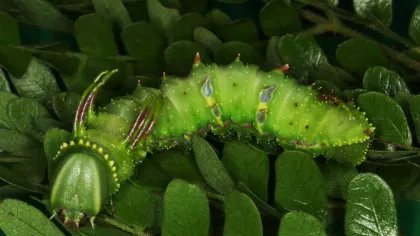7 March 2025
3 min read
Mosquitoes' sugary weakness: A new weapon against malaria?
Could plants be the key to combatting malaria? New research uncovers the link between this deadly insect’s diet and disease transmission.

Stealthy, tenacious, and deadly - mosquitoes are the ultimate hidden killers, infecting people with devastating diseases like malaria, dengue, Zika, and West Nile virus.
For decades, we’ve fought back with bed nets and insecticides, but mosquitoes are adapting to these efforts, developing resistance, and outpacing our defences. As these established tools falter, the race is on to find a new, smarter way to stop them in their tracks.
Our latest research, published in Scientific Reports, uncovers a surprising weakness in mosquitoes’ survival strategy—one that we can potentially exploit.
The food mosquitoes need along with blood
It may come as a surprise, but female mosquitoes feed on both blood and flower nectar. In fact, due to their very high energy demands to fuel their flight and survival, nectar is the primary energy source for mosquitoes.

Recent research shows that, like with bees and other pollinators, floral nectar provides an ideal energy source for mosquitoes, and an abundance of flowers in landscapes can increase their populations and the risk of disease transmission.
So, by pinpointing the plants that mosquitoes crave the most and strategically removing them from high-risk areas, we could disrupt this nutritional lifeline, reducing their numbers and - crucially - the spread of deadly diseases.
Unlocking the hidden diet of mosquitoes
But in the vastly plant diverse tropics, how do we know from which plants mosquitoes have fed? We cannot observe them, as much of their feeding activities occur at night. To understand which plants they prefer, we analysed the nectar of various species known to grow in malaria-prone regions.

By examining metabolites - unique chemical compounds found in plant nectar - and comparing this with analyses of mosquitoes, we were able to track which plants the mosquitoes had been feeding on by matching up the chemical fingerprints.
Unlike traditional DNA barcoding, which depends on extracting plant DNA from the mosquito’s gut (a tricky process given their tiny nectar meals and the limited plant DNA in nectar), metabolite analysis provides a reliable way to identify nectar sources.
For this study, we selected three candidate species: yellow sage (Lantana camara), castor oil plant (Ricinus communis), and yellow oleander (Cascabela thevetia). These plants, all found in tropical regions, were known to be common ornamental species in Bobo-Dioulasso, Burkina Faso, one of our key research locations.

A potential game-changer in disease control
By identifying the plant species that mosquitoes rely on for energy, we reveal new possibilities for mosquito control.
If certain plants are acting as ‘fuel stations’ for disease-carrying mosquitoes, then removing them from residential areas or disease hotspots could significantly reduce mosquito populations and lower transmission rates. We could even use targeted insecticide application on the flowers of key plant species.
With insecticide resistance on the rise, we urgently need new ways to reduce mosquito populations. Understanding their plant preferences allows us to explore innovative strategies, such as habitat management, to control disease transmission.

Looking ahead
This research - carried out with our partners in Burkina Faso and the Natural Resource Institute - is part of a wider effort at Kew to study the relationships between plants and insects, including pollinators like bees, natural enemies of pests and disease-spreading species. By better understanding how nectar chemistry influences insect behaviour, we hope to develop new, nature-based solutions for disease and pest control.
While more research is needed to determine how effective plant removal would be on a large scale, our findings open the door to a promising new approach. By tweaking mosquito habitats and removing their preferred nectar sources, we may have found an innovative way to bite back against malaria and other deadly diseases.

.jpg.webp?itok=mtqvCkBt)
.jpg.webp?itok=b2-IiU49)

